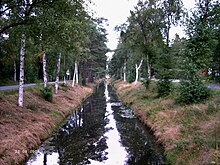Jürgen Christian Findorff

Jürgen Christian Findorff (born February 22, 1720 in Lauenburg / Elbe ; † July 31, 1792 in Bremervörde ; buried on August 3, 1792 in Iselersheim near Bremervörde) became known as a peat colonizer. He measured, drained, and populated the moors between Wümme and Hamme , the Teufelsmoor northeast of Bremen . Because of his commitment to the colonists, he was nicknamed the "father of all peat farmers".
Life
Jürgen Christian Findorff was born as the son of the cabinet maker Hinrich Möller in Lauenburg on the Elbe. According to the church book, this was called "Findorff" from 1720 onwards. Like his younger brother Johann Dietrich Findorff (1722–1772), who later worked as a court painter at the Mecklenburg court, he first learned the carpentry trade from his father. At the age of 19 he took over his father's workshop. Due to his skill, the Hanoverian agricultural master promoted him and provided Findorff with further training in the areas of hydraulic engineering and land surveying . Findorff led the construction of the Worpswede Zionskirche (1757–1759), and he also designed and built the churches in Grasberg (1781–1789) and Gnarrenburg (1784–1790). He was also responsible for building mills, bridges and town halls.
Peatland colonization
From 1751 Findorff worked on the moor colonization , a project by the Elector of Hanover to drain and settle the moors between Wümme and Hamme. He founded numerous villages in the Teufelsmoor , initially Wörpedorf (1751) and Eickedorf (1753).


In this context, the Osterholzer Hafenkanal was built in 1765/66 , which leads from the Hamme near Tietjens Hütte to the outskirts of today's Osterholz-Scharmbeck . In addition, Findorff was involved in the construction of the Hamme-Oste Canal (1769–1790) and the Oste - Schwinge Canal (from 1772).
On September 20, 1771 he was by a certificate from Georg III. appointed official moor commissioner. That Findorff was concerned not only with the technical side of land reclamation, but also with the well-being of the settlers, is among other things. a. from the bog catechism he wrote for Findorff settlements .
From 1782 Findorff relocated his activities in the moor colonization in the area around Bremervörde . In total he founded 42 new villages on 140 km² of moorland. In 1799 an obelisk was erected in his memory on the Weyerberg near Worpswede .
Named after Findorff
In numerous places in the region, streets and paths are named after him today.
-
Bremen-Findorff , a district in Bremen
- there the Findorffallee, Findorffstraße , Findorff school center and Findorfftunnel
- Findorf (founded in 1780, in Gnarrenburg since 1974 )
- Findorff House in Osterholz-Scharmbeck (former Findorff's official residence)
- Elementary school "Findorffschule" in Rübhofstrasse in Osterholz-Scharmbeck
- Elementary school "Findorff Elementary School" Iselersheim
- Findorff Church in Iselersheim
- Findorff House, museum with a permanent exhibition on Findorff and the peatland colonization, in Iselersheim
- Findorff secondary school in Bremervörde
- A replica of a peat barge
- Findorff pharmacy in Grasberg
- Findorffhof farm complex in Grasberg
- Secondary and secondary school "Findorffschule" in Grasberg
- Findorffstrasse in Lauenburg / Elbe
- Findorffstrasse in Worpswede
- Findorffstrasse in Osterholz-Scharmbeck
- Findorffstrasse in Bremervörde
- Jürgen-Christian-Findorff-Str. in Lilienthal
- Elementary school "Findorff-Grundschule" Neudorf-Platendorf
- Findorff-Weg in Neuenkirchen
Exhibitions
- 2012: The brothers Findorff - Exhibition of 18 March until 30 September 2012 in the Art Show Lilienthal the Lilienthaler Art Foundation in Lilienthal (near Bremen)
literature
- Karl Ernst Hermann Krause: Findorf, Jürgen Christian . In: Allgemeine Deutsche Biographie (ADB). Volume 7, Duncker & Humblot, Leipzig 1877, p. 15.
- Erich Weise: Findorff, Jürgen Christian. In: New German Biography (NDB). Volume 5, Duncker & Humblot, Berlin 1961, ISBN 3-428-00186-9 , p. 157 ( digitized version ).
- Tim Wöbbeking: The Findorff brothers. In: Heimat-Rundblick. History, culture, nature . No. 101, 2/2012 ( summer 2012 ). Druckpresse -Verlag , ISSN 2191-4257 , p. 9.
Web links
- In the footsteps of the bog colonizer Jürgen Christian Findorff
- Files on the appointment of Moor Commissioner Jürgen Christian Findorff by King Georg III., 1771–1793, 252 sheets on kulturerbe.niedersachsen.de
- The Findorff Brothers at the Lilienthal Art Foundation , Lilienthal (near Bremen)
Individual evidence
- ↑ The Findorff Brothers ( Memento of the original from November 24, 2011 in the Internet Archive ) Info: The archive link was automatically inserted and has not yet been checked. Please check the original and archive link according to the instructions and then remove this notice. . On: Website of the Lilienthal Art Foundation , Lilienthal. Retrieved July 31, 2012.
| personal data | |
|---|---|
| SURNAME | Findorff, Jürgen Christian |
| BRIEF DESCRIPTION | Peat colonizer |
| DATE OF BIRTH | February 22, 1720 |
| PLACE OF BIRTH | Lauenburg / Elbe |
| DATE OF DEATH | July 31, 1792 |
| Place of death | Bremervörde |
